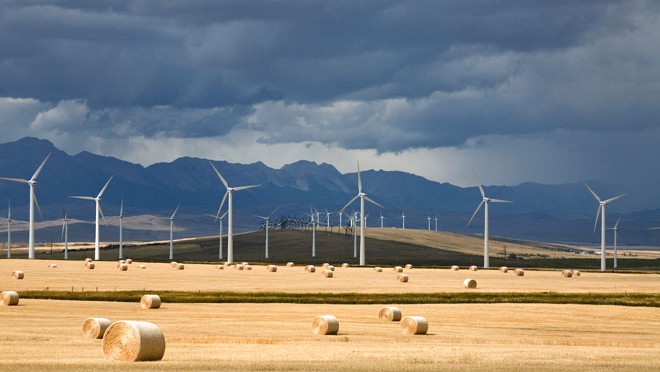Alberta can once again be a leader in renewable energy development and address global concern about the province’s environmental record by meeting rising electricity demand with new clean wind energy.
WindVision 2025: A Strategy For Alberta, released today by the Canadian Wind Energy Association (CanWEA), makes the case for the strategic deployment of more wind energy in Alberta in a direct response to a challenge by Alberta Energy Minister Ken Hughes for the renewable industry to put forth policy solutions to help “green the grid”.
Since the country’s first wind farm was constructed in southern Alberta in 1993, the province has installed 1,100 MW of wind energy – but this represents just a small fraction of the available resource. Alberta currently sits in third place for total installed wind energy capacity – behind Ontario and Quebec. WindVision 2025 makes the case that Alberta is well positioned to take strategic advantage of its significant wind resource, access to skilled trades, and interest by independent power producers.
“Wind energy can provide substantial amounts of new clean electricity to Albertans while at the same time contributing to rural economic development and addressing concerns about increases in greenhouse gas emissions from the province’s broader energy sector. Without immediate action by policymakers, however, the prospects for additional wind energy development in Alberta are limited,” said Robert Hornung, president of CanWEA. “WindVision 2025 proposes measures that will address barriers to wind energy development and help the province meet its goals of reduced greenhouse gas emissions while returning to a leadership role in clean renewable energy production.”
CanWEA’s WindVision for Alberta demonstrates that Alberta has about 5,000 MW of easily accessible wind resources that can produce energy at a more affordable cost than virtually any other form of electricity generation available today. However, the structure of the province’s current competitive electricity market makes it very difficult for new wind farms to be financeable and to secure the revenues needed to be economically viable.
CanWEA has identified two complementary policies that, if implemented together, have the potential to allow the industry to overcome these barriers:
Clean Electricity Standard: to impose a maximum greenhouse gas emissions-intensity level, measured in tonnes CO2e/MWh, on electricity sold by retailers in the province. The Alberta government would set this technology-neutral standard and retailers would seek contracts with developers of different sources of electricity generation in the marketplace to ensure their supply portfolios met the target.
Increase in carbon price: a second supplementary measure is an increase in the $15/tonne carbon price imposed on large emitters under Alberta’s existing Specified Gas Emitters Regulation (SGER), something the province has already acknowledged it needs to do to encourage the investment choices and technology advances that will allow it to meet its climate change targets.
“Neither of these policy measures alone will totally address the challenges facing wind energy in the province, but they are very complementary,” said Hornung. “A Clean Electricity Standard will incent long-term contracts for electricity and help provide the long-term revenue certainty needed to finance new projects. An uplift in the carbon price will increase the value of greenhouse gas offsets produced by wind energy projects, providing an additional revenue stream that will improve project economics.” When it comes to benefits, the impact of developing the province’s wind energy resource is substantial.
From an environmental perspective, every 150 MW wind farm built in Alberta:
- Reduces Alberta’s GHG emissions by 300,000 tonnes a year – equivalent to taking 60,000 cars off the road
- Reduces water consumption by 480 million litres a year, relative to natural gas generation – equivalent to the volume of 160 Olympic-sized swimming pools.
Wind energy development pays significant economic dividends as well. Every 150 MW of new capacity represents:
- $316 million in investment
- 140 full-time equivalent jobs in construction
- 10 permanent jobs in operations and maintenance
- $17 million in lease payments to landowners over 20 years
- $31 million in property tax payments to municipalities over 20 years
“The reality is Alberta’s energy sector is the target of growing international scrutiny over how it is tackling rising greenhouse gas emissions while jurisdictions that include the European Union and California are working on low-carbon fuel standards that could limit potential markets for Alberta’s fossil fuel resources,” said CanWEA’s Alberta regional director, Lana Norgaard. “Immediate and real actions to implement WindVision can help return Alberta to a leadership role in clean renewable energy development, reduce greenhouse gas emissions – while respecting the province’s commitment to technology neutral, market-based solutions.”
Download a copy of WindVision 2025: A Strategy For Alberta and the Alberta WindVision Technical
Overview Report at: www.canwea.ca/albertawindvision.


